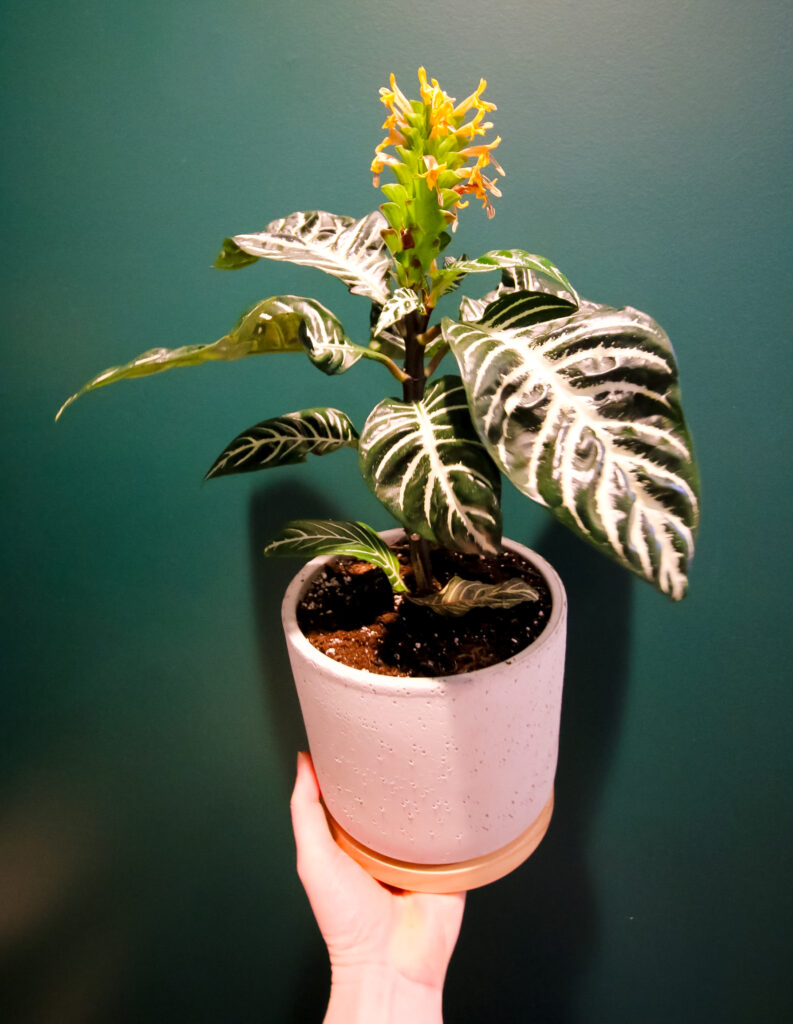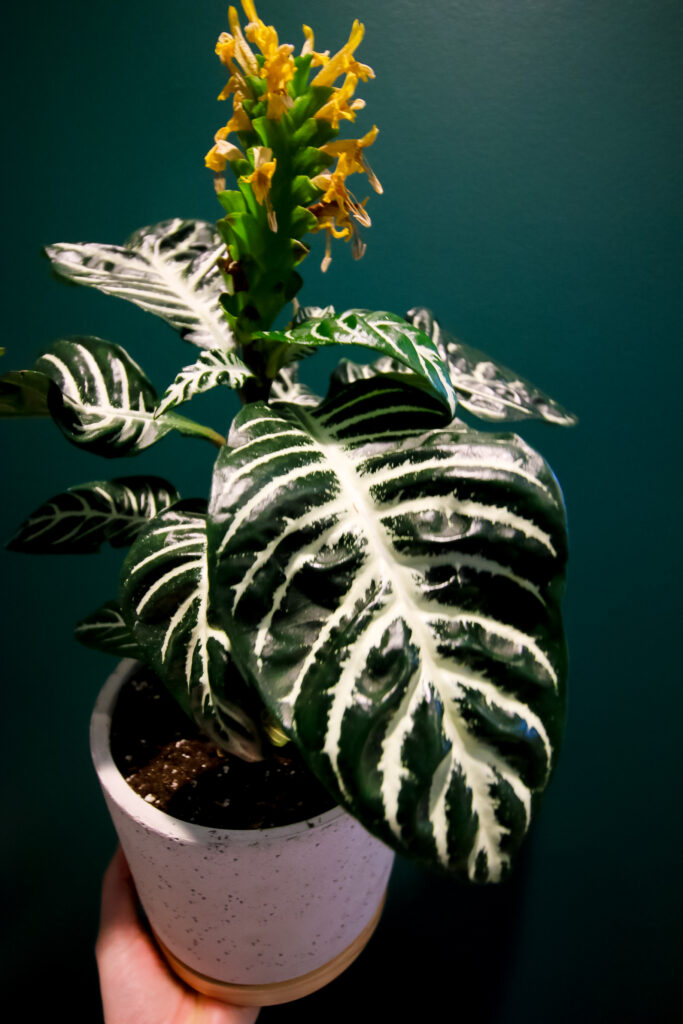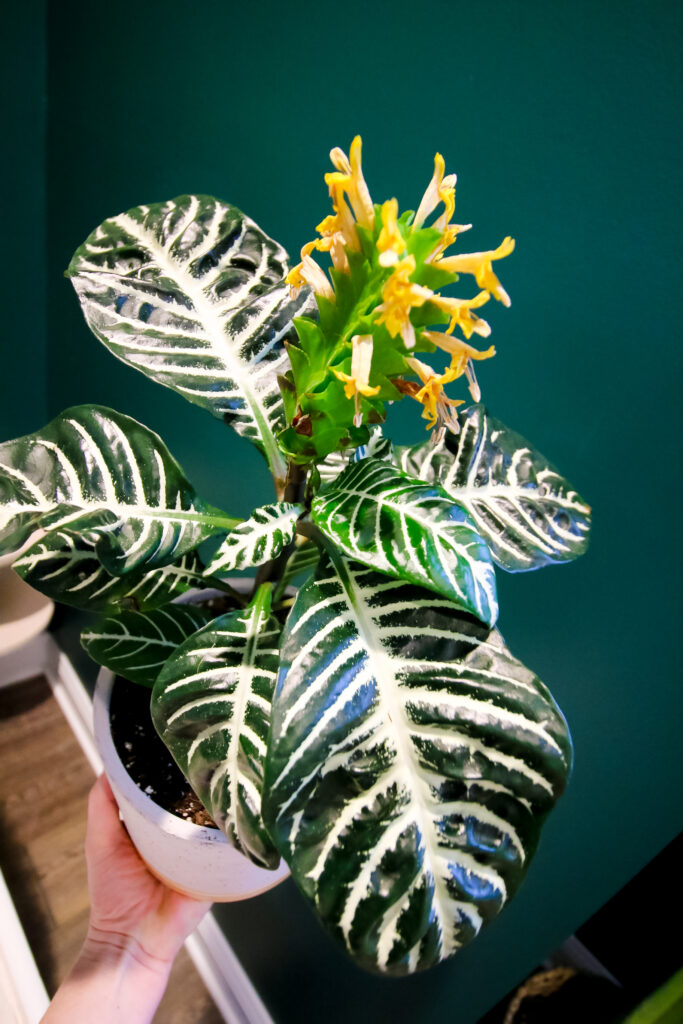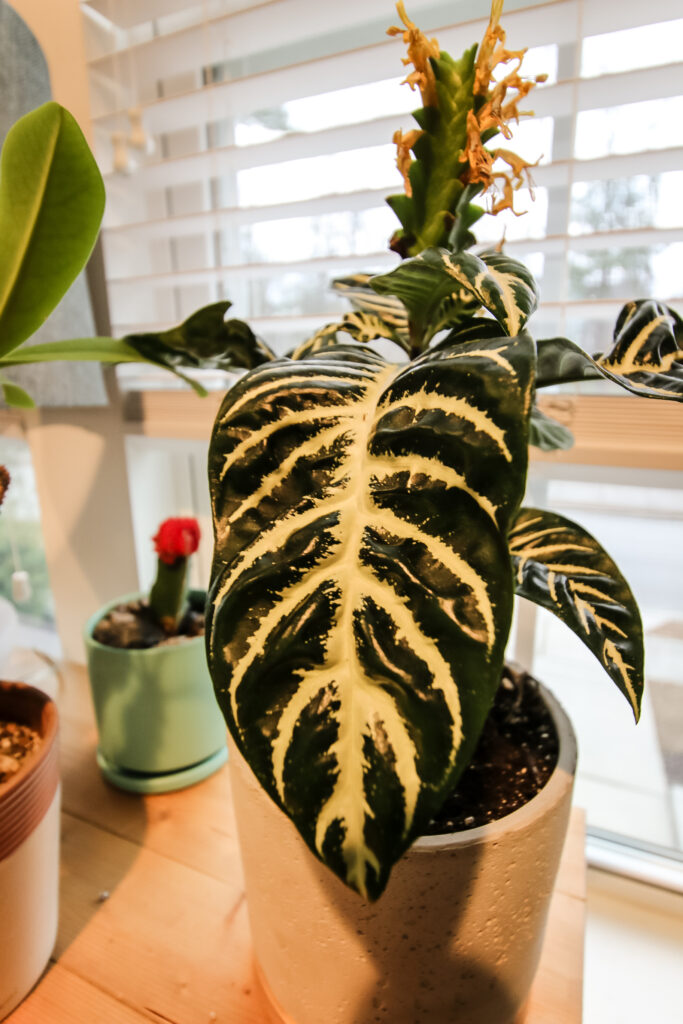Want to add a Zebra Plant to your houseplant collection? They're beautiful and surprisingly easy to care for! Here's my complete Zebra Plant care guide, designed to be easy to understand, beginner-friendly, and educational!
As you might imagine, I have a lot of house plants. But, my husband and mom both still like to gift me houseplants for different occasions.
It can be kind of hard to find a plant that I don't already have that would thrive in our home.
But, for Christmas, my husband let our three year old daughter pick me out a plant and I am so excited that she picked me out a zebra plant.
Let's talk about what the zebra plant is and how to keep a happy in your home.

What is a Zebra Plant?
The Zebra Plant, scientifically known as Aphelandra Squarrosa, is a striking plant known for its bright green leaves and vivid white veins, resembling the stripes of a zebra.
It's not just the leaves that are beautiful; this plant also blooms with yellow flowers that can add a pop of color to any room.
Other names for Zebra Plant include:
- Striped Aphelandra
- Saffron Spike
Zebra Plant Origins
The Zebra Plant originates from the Brazilian rainforests, thriving in warm and humid conditions.
The forest floor, full of organic material, explains the plant's preference for nutrient-rich, well-draining soil.
The shaded undercanopy replicates the indirect light conditions ideal for indoor growth.
Once you understand it's natural environment, you can try to replicate these conditions in your home garden.

Is Zebra Plant Rare?
While not extremely rare, the Zebra Plant is a unique addition to houseplant collections due to its distinctive appearance.
My family found this plant at a specialty garden store. I haven't seen it at Home Depot before, but I bet it will be there soon!
Is Zebra Plant Toxic?
No, the Zebra Plant is not toxic, making it safe around pets and children.
Zebra Plant Care Guide
Here are the essential care needs of a Zebra plant!

Zebra Plant Watering
Proper watering is crucial for Zebra Plants. They prefer evenly moist soil but do not like to sit in water. Read my guide on how to drill drainage holes in pots to prevent waterlogging!
How often should I water my Zebra Plant?
Water your Zebra Plant when the top inch of soil feels dry. This may be about once a week, but it's essential to adjust based on your home's humidity and temperature.
I have found that my zebra plant is very dramatic when it's thirsty. By this, I mean that the leaves look very withered and sad when it dries out.
However, I think this is a good thing. It is telling you that it is thirsty. If you water it when it starts looking like this, it should perk up within 12 hours.
Should I mist my Zebra Plant?
Yes, misting can help replicate the humidity of its naturally humid rainforest environment.
However, ensure not to overdo it, as too much moisture can lead to fungal issues, or rot.

Zebra Plant Lighting Needs
Zebra Plants prefer bright, indirect sunlight. Direct sun can scorch their leaves, while too little light can cause them to lose their vibrant stripes.
Can I keep Zebra Plant outdoors?
In most climates, it's best to keep your Zebra Plant indoors. However, in warm, frost-free climates, they can thrive outdoors in shaded areas.
If you move them outdoors in the summer, be sure to keep it out of direct sun, which will burn the leaves. Move them indoors when overnight temperatures drop below 50 degrees.

Zebra Plant Soil + Potting
Use a well-draining soil mix and ensure your pot has drainage holes. Zebra Plants do not like to be root bound, so repotting every couple of years can keep your plant healthy.
Does Zebra Plant need a moss pole?
No, the Zebra Plant does not typically require a moss pole, as it is not a climbing plant.
Zebra Plant Fertilization
Fertilize your Zebra Plant every 4-6 weeks during the growing season with a balanced, water-soluble fertilizer to support its growth and flowering.
How to Propagate Zebra Plant
It is extremely easy to propagate Zebra Plant in water.
- Identify that you have a healthy plant, preferably with new growth.
- Snip the stem with sharp scissors, cutting off a piece 3-4 inches in length.
- Remove any lower leaves.
- Place in water so at least 1 - preferably 2 - nodes are underwater.
- Change the water once a week and top off as necessary.
- See roots form in 2-4 weeks.
- Once the roots are 2-3 inches long, plant in soil.
You can also propagate the cutting in moist soil with rooting hormone on the cut end.
When I root cuttings in soil, I like to cover the pot loosely with a clear plastic bag, like a produce bag from the grocery store. This creates a little greenhouse effect and keeps the humidity super high, which helps to encourage rooting.

Troubleshooting Zebra Plant
Here are some common problems and issues with the zebra plant and what to do about them.
Why are my Zebra Plant's leaves turning yellow?
Yellow leaves can indicate overwatering or poor drainage. Ensure your pot has drainage holes and adjust your watering schedule as needed.
Why are the tips of my Zebra Plant's leaves turning brown?
Brown tips can be a sign of low humidity or inconsistent watering. Try to increase the humidity around your plant, perhaps by placing it on a pebble tray with water or using a humidifier. Also, keep the watering schedule consistent.
My Zebra Plant's leaves are dropping. What's happening?
Leaf drop can occur due to a variety of reasons including drastic temperature changes, overwatering, or under-watering. Ensure your Zebra Plant is kept in a stable environment without sudden temperature changes and adjust your watering routine to make sure the soil is moist but not soggy.
How often should I repot my Zebra Plant?
Zebra Plants typically need to be repotted every 1-2 years or when they outgrow their current pot. Spring is the best time to repot, giving the plant fresh soil and more room to grow before the growing season.

Can the Zebra Plant survive in low light conditions?
While Zebra Plants can survive in low light, they won't thrive or produce blooms. If you notice your plant's stripes fading, it's a sign it needs more light. Try to provide bright, indirect sunlight for optimal growth.
How can I encourage my Zebra Plant to bloom?
To encourage blooming, provide your Zebra Plant with plenty of bright, indirect sunlight, keep the soil consistently moist, and maintain high humidity.
Also, using a phosphorus-rich fertilizer during the growing season can help stimulate blooms.
The leaves of my Zebra Plant are curling. What does this mean?
Leaf curling usually indicates the plant is not receiving enough water or humidity. Check the soil moisture and consider increasing the humidity around the plant. Curling can also be a response to too much direct sunlight, so ensure your plant is in a spot with bright, indirect light.
With its unique appearance and the joy it brings when it blooms, a Zebra Plant is a wonderful addition to any indoor garden.
Remember, patience and attention to its basic needs will keep your plant thriving for years to come. Happy planting!
Thanks for reading!


Hey there, I'm Morgan, a houseplant enthusiast from sunny Charleston, South Carolina. Growing up surrounded by my mom's lush orchids and African violets, I discovered the magic of bringing nature indoors. Thanks to the pandemic, I delved deeper into houseplants, discovering their power to uplift moods and transform spaces. I'm here to spill all my secrets, helping you pick the perfect houseplant - and make it happy. Let's keep your plants alive, together! 😊
